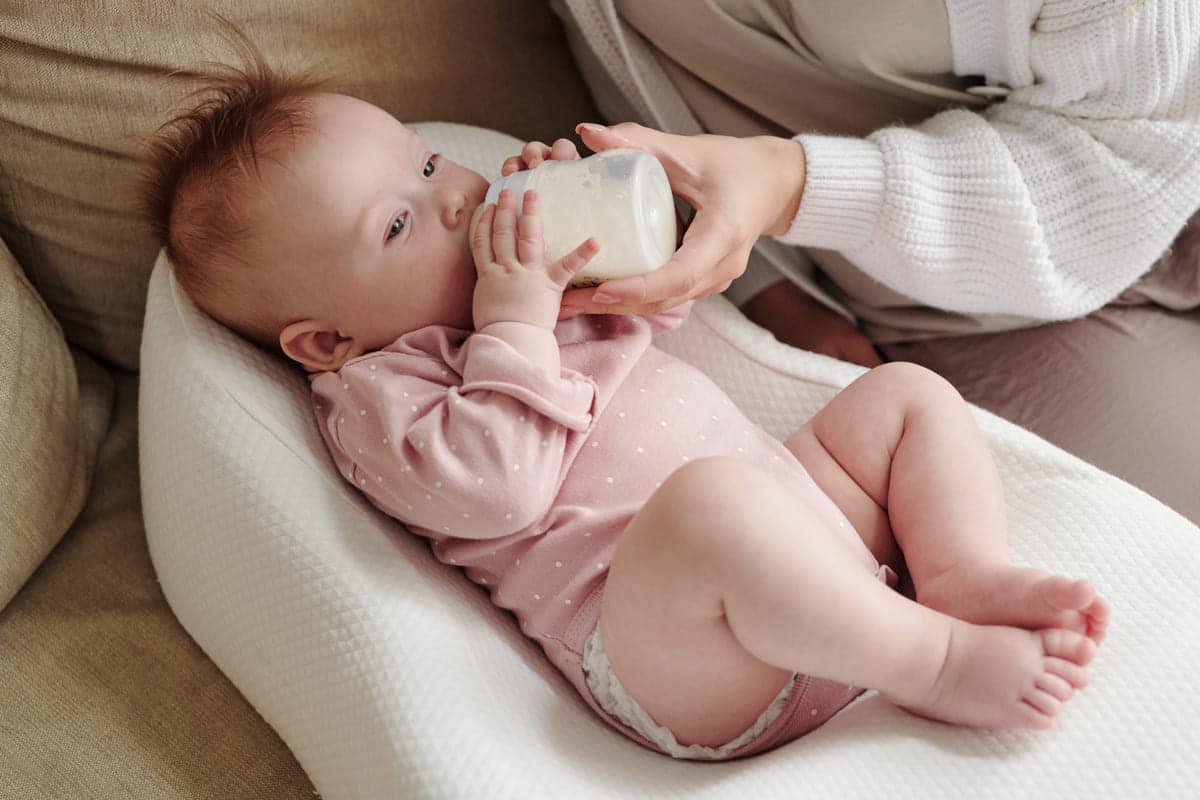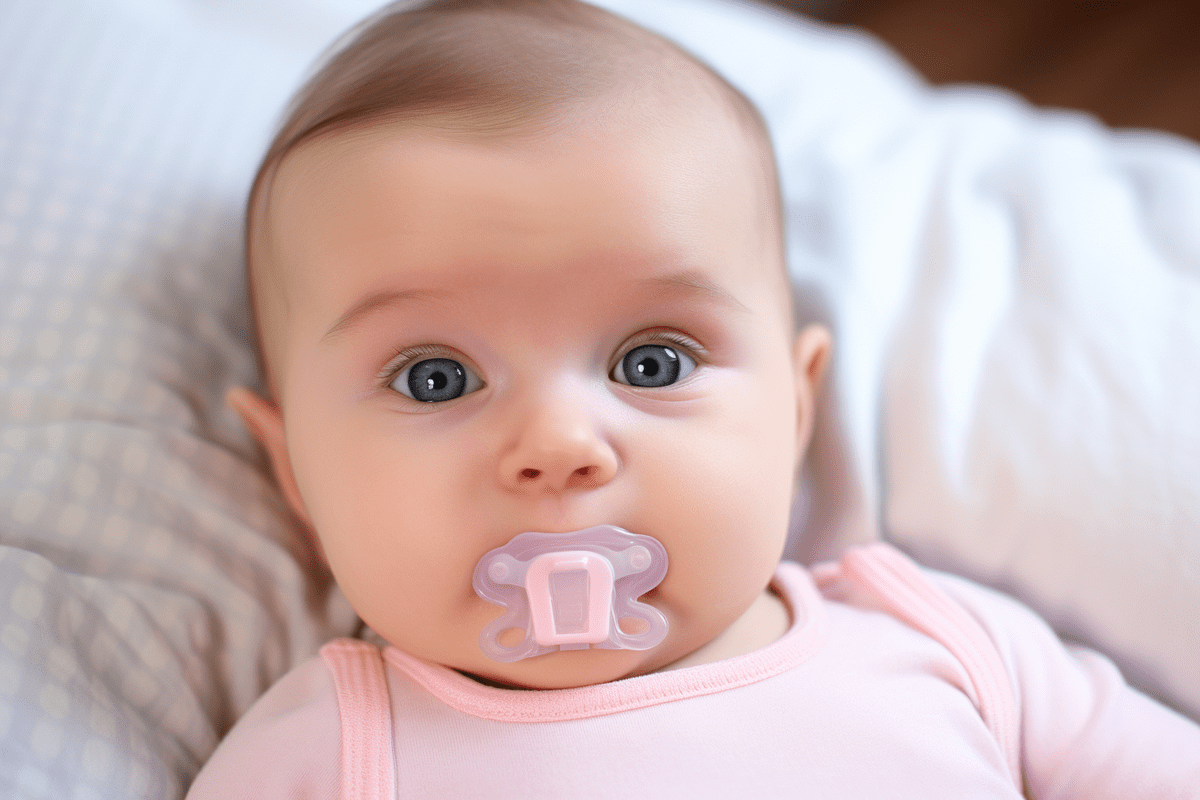Babies are known for their incessant need for attention, especially during the night. But why do they cry at night? Is it hunger, discomfort, or just a way to communicate? Understanding the reasons for your baby crying can help you soothe them and get some much-needed rest.
Generally, fussy babies tend to cry more in the evening and at night, which can be exhausting for new parents. According to the National Institutes of Health, this pattern of crying is known as ‘the witching hour’ and typically occurs between 6 pm and 10 pm.
But this is completely normal as babies’ internal clocks are still developing, and they have shorter sleep cycles than adults. So, let’s dive into 9 ways you can soothe your crying baby and get them (and yourself) some much-needed rest!
In This Article
Why babies cry at night?
Babies, especially young ones, have a limited range of communication tools. One of their most effective methods to express a variety of needs and discomforts is crying. There are several reasons why a baby cries at night, and it’s crucial for caregivers to understand these to respond effectively.
Hunger

Many babies cry at night because they are hungry. Given the small size of their stomachs and their rapid growth, young babies need frequent feeding, even during the night. Hunger is often a major reason for a baby crying during sleep. On the other hand, older babies may cry if they have not eaten enough during the day or if they are going through a growth spurt.
Discomfort
Discomfort can arise from various reasons – a wet or soiled diaper, being too hot or cold, or even an uncomfortable sleeping position. Such discomfort often leads to babies’ sleep being disturbed, resulting in them crying.
Colic

Colic is a condition that leads to recurrent crying in the early months. It can cause a baby to cry for over three hours a day, often in the evening. Baby is crying at night can also be due to colic. If you suspect your baby has colic, consult a doctor for proper diagnosis and treatment. Moreover, colic can be frustrating for parents, but it is usually a temporary phase that resolves on its own.
Growth Spurts
Babies go through phases of intense growth, commonly around 2 weeks to 3 months. During these growth spurts, they may need more food and may wake up hungry and crying. However, a teething baby can also cause discomfort, leading to disturbed sleep and crying.
Developmental Phases

As babies grow, they become more aware of their surroundings. This developmental phase can lead to separation anxiety, causing many babies to cry when put to bed without their primary caregiver. Furthermore, as they grow and become more active, babies may cry out of frustration if they are unable to do something they want. It is important for parents to understand these phases and provide necessary support and reassurance to their baby.
Feeling unwell
Sometimes, a baby’s cry may indicate that they are feeling unwell. This could be because of an illness or an injury. If your baby has other symptoms like fever, vomiting, or diarrhea, it is essential to consult a pediatrician for proper diagnosis and treatment.
Overstimulation

Babies are highly sensitive to their environment, and too much stimulation can cause them to become fussy and cry. This is especially true during bedtime when babies are already tired. It is important for parents to create a calm and soothing environment for their baby before putting them to bed.
9 best ways to soothe them
Baby crying is one of the most common challenges that parents face, especially for new parents. It can be stressful and overwhelming to try and figure out why your baby is crying and how to soothe them. To help your baby sleep better, here are the best tips that can help soothe them and make bedtime easier for both you and your little one.
1. Establish a Consistent Bedtime Routine

A predictable bedtime routine can signal your baby that it’s time to wind down and go to sleep. This routine could include activities like a warm bath to soothe and relax your baby, reading a book to instill a love for reading early on, or singing soft lullabies to comfort your little one. You might also incorporate gentle massage or cuddle time into this routine. The key is consistency – doing the same activities in the same order at the same time each night. This provides security and predictability for your baby, making sleep transitions easier.
2. Respond to Their Needs Promptly
If your baby has a wet or dirty diaper, it’s crucial to change it promptly to prevent discomfort or potential rashes. Some babies are particularly sensitive and may be disturbed by wet diapers at night, disrupting their sleep. On the other hand, some babies might not mind a wet diaper and can sleep through the night undisturbed. In such cases, you may not need to change them unless the diaper becomes soiled. Remember, a clean, dry diaper creates a comfy sleep environment, ensuring healthier and uninterrupted rest for your little one.
3. Create a Comfortable Sleep Environment
It’s vital to ensure that the room is at a comfortable temperature, neither too hot nor too cold, as extreme temperatures can disrupt your baby’s sleep. The crib should be safe and cozy, with a firm, flat sleep surface devoid of any loose items that could pose a risk. This peaceful setting greatly improves your child’s sleep. A well-settled bedroom environment, consistent throughout the night, helps in falling asleep faster and easier. Moreover, this comfort can help your baby stop crying by providing a sense of security and tranquility, thus promoting healthier, uninterrupted child sleep.
4. Feed Your Baby Before Bed

When your baby’s belly is full, they’re usually content, and that can lead to better sleep. Feeding before bed can be a simple, effective way to soothe a fussy baby, helping them transition from their awake time to their sleep time more smoothly. This strategy is particularly beneficial for a fussy baby who might be struggling with sleep due to hunger pangs. However, it’s crucial to ensure that your baby is fed enough during the day so they are not overly reliant on feeding before bed for sustenance. Finding a balance is key to establishing healthy eating and sleeping habits.
5. Use White Noise
The sound of a fan, a white noise machine, or a white noise app can mimic the sounds your baby heard in the womb, which were constant and comforting. This familiar noise can help a fussy baby calm down and fall asleep, creating an acoustic environment similar to what they experienced before birth. However, make sure to keep the volume low and at a safe level for your baby’s sensitive ears. This method can also be utilized during nap times to help your baby stay asleep longer and wake up less frequently.
6. Swaddle Your Baby

Swaddling can recreate the snug, cocoon-like feeling of the womb, providing an immense sense of comfort and helping your baby transition into a peaceful sleep. This strategy is great for a fussy baby as the snug wrap provides a sense of security and soothes their agitation. The gentle pressure of a swaddle can mimic a warm hug, helping to calm your little one. However, while swaddling can be a valuable tool in your parenting arsenal, it’s crucial to follow safe swaddling guidelines. Incorrect swaddling may cause hip dysplasia or overheating, so prioritize your baby’s safety and comfort when using this method.
7. Use Gentle Motions
The soothing rhythm of rocking, swinging, or bouncing can significantly help pacify a fussy baby. These gentle, rhythmic motions serve as a comforting reminder of their time spent in the womb, where similar movements constantly cradle them. This familiarity can be incredibly calming for them, easing their agitation and helping to transition them into a peaceful state. Moreover, these movements can be paired with other soothing techniques like humming or singing a lullaby, further enhancing their calming effect. Creating a serene environment helps your little one feel safe and secure, leading to better sleep and less fussiness.
8. Offer a Pacifier

For many infants, the action of sucking on a pacifier can have a significantly soothing effect. It’s a natural reflex that not only helps provide a comforting sense of security but also aids them in achieving a state of relaxation, easing their transition into sleep. Pacifiers can also help prevent night wakings, as they can act as a self-soothing mechanism for babies who may be struggling to fall back asleep on their own. It’s essential to choose a pacifier that is the right size for your baby and ensure that it is always clean and in good condition to avoid any potential safety hazards.
9. Get Acquainted With Their Sleep Cycles
Babies, particularly newborns, exhibit sleep cycles that greatly differ from those of adults. They tend to spend more time in the realm of light sleep, a phase during which they are susceptible to waking up easily. Gaining an understanding of these unique sleep patterns is crucial as it can equip you with the knowledge needed to respond more effectively to their needs. This insight can assist you in devising strategies to help them return to sleep when they do awaken, thus ensuring they get the rest they require for healthy growth and development.
When to let out your baby cry?
Determining the appropriate time to let your baby cry can be a challenging decision for many parents. However, experts often suggest that the ‘cry-it-out’ method is typically suitable for babies who are at least 4 to 6 months old. This doesn’t imply that younger babies can’t start learning some self-soothing techniques in the meantime.
The ‘cry-it-out’ method is an approach where you allow your child to cry for a specified, usually short, period before offering comfort. The primary goal is to help your child learn to fall asleep on their own and establish a healthy bedtime routine.
However, it’s crucial to note that this method doesn’t mean leaving your baby to cry indefinitely but involves gradually extending the time between your responses to their crying. Babies often experience sleep regression, a period when a baby who has been sleeping well suddenly starts waking up at night or skipping naps.
During these periods, it might be tempting to respond to your baby’s cries immediately. If your baby continues to cry intensely after 3 nights or a week, it might be time to try a different approach or consult a pediatrician.
What is the normal sleep pattern for a baby by age?
Understanding the normal sleep pattern for a baby by age is crucial for parents, as it helps in establishing healthy sleep habits and ensures that the baby gets ample rest.
Newborns (0–1 month)
Newborns sleep a lot, typically between 14 to 18 hours a day. Their sleep cycle is irregular, with periods of 1 to 3 hours spent awake. During this stage, it’s important to respond promptly when your baby wakes and cries, as they usually need something urgently, like bottle feeding or a diaper change.
Older Newborns (2–3 months)
As babies grow, their sleep patterns start becoming more structured. Older newborns typically need about 15 hours of sleep, which includes 3–5 naps during the day. They can sleep for longer stretches but will still wake up several times for feedings and diaper changes.
Infants (4–12 months)
By the time babies reach this age, their sleep patterns become more like those of adults[^1^]. Infants require 12 to 15 hours of sleep. This includes 3-4 naps during the day for younger infants (3-5 months), reducing to 2-3 naps for older infants (6-12 months). At this age, babies start developing the ability to self-soothe, which means they may stop crying and go back to sleep without your intervention.
Toddlers (12 months and older)
After their first birthday, toddlers typically sleep for 12 to 15 hours a day. This includes one or two daytime naps and a longer sleep at night. Toddlers are also going through a lot of development and growth, which can sometimes disrupt their sleep. It’s also around this age that sleep regressions typically occur, where a toddler who has been sleeping well suddenly starts waking up at night or skipping naps.
The Bottom Line!
Every baby is different, and their sleep patterns will vary. It’s important for caregivers to understand that crying is a normal part of a baby’s communication and not always an indication of something serious. By understanding the reasons behind a baby’s cry, parents can respond effectively and provide the necessary support to ensure their baby gets the rest they need for healthy development. However, as your baby grows and changes, their sleep habits will also evolve, and it’s important to adapt accordingly.










![Home Renovation Guide [2025]](/app/uploads/2021/04/design-hacks-1-378x300.jpg)
